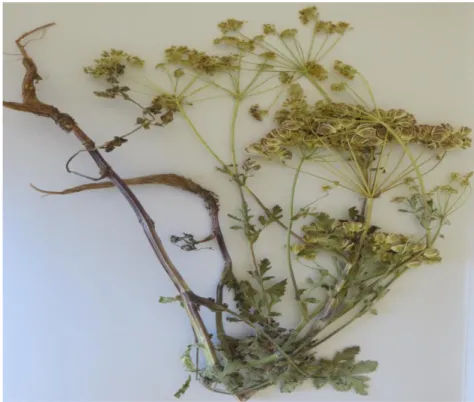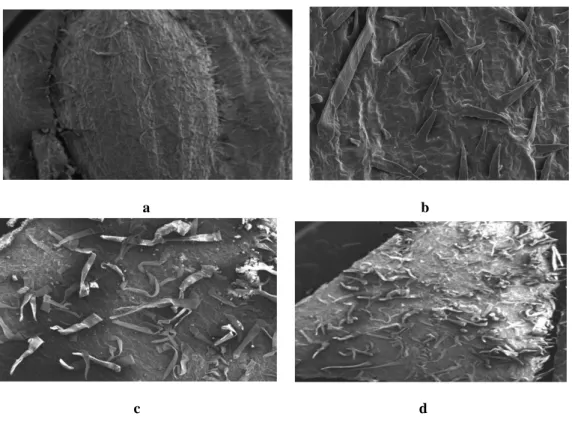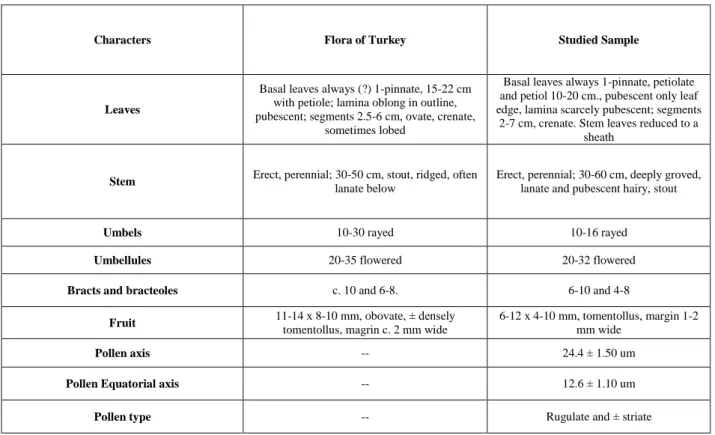Araştırma Makalesi/Research Article
A
Morphological Study On Endemic Malabaila lasiocarpa
Boiss. (Apiaceae) From Bingol (Turkey)
Ömer KILIÇ
1Abstract- In this study morphological characters of Malabaila lasiocarpa Boiss. has been performed and compared with the Flora of Turkey for the systematic purposes. Studied sample has shown some variations from Flora of Turkey sample in respect to some characters which are shown in Table 1. Besides, with this study new morphological properties have determined for diagnostic purposes and the description of studied sample have extended.
Key words: Apiaceae, Malabaila, Morphology, Systematic.
I. INTRODUCTION
The Umbelliferae (or Apiaceae) family has a cosmopolitan spreading, but most of Apiaceae taxa are confined to northern temperate areas, and high altitudes in the tropic regions [1]. Apiaceae (in Turkey called „Maydanozgiller‟) has annual and perennial herbs, rarely shrubby, the leaves are generally alternate, hollow stems, usually exstipulate, the petioles are often large and sheaed at the base, the inflorescence is usually a compound umbel, and the flowers are generally hermaphrodite [2]. Apiaceae is a large family, composed of more than 3.700 species belonging to 434 genera all around the world [3]. In Turkey, Umbelliferae is represented by about 102 genus and 465 species from which 130 are endemic, with a 30% endemism rate [2, 4-6]. Plants of this family, generally known as carrot or parsley family, are mostly aromatic and economically important plants are well known with regard to their economic significance and varied profile of essential oils [7].
The genus Malabaila Hoffm. belongs to Apiaceae family, and is represented by 6 species (M. aurea (Sm.) Boiss., M. involucrata Boiss. & Spruner, M. lasiocarpa Boiss., M. pastinacifolia Boiss. et Bal., M. dasyantha (K. Koch) Grossh., M. secacul Banks & Sol.) in Flora of Turkey. Malabaila lasiocarpa is an endemic plant and described as erect perennial; stem 30-50 cm, stout, ridged, often lanate below, basal leaves always (?) 1-pinnate, petiolate, petiol 15-22 cm and Iran-Turanian element in Flora of Turkey [2].
In the present study, new morphological characters were determined and diagnostic characters of M. lasiocarpa were rainforced.
II. MATERIALS AND METHODS A. Plant Material
M. lasiocarpa was collected from their natural habitat by O. Kilic (Leg. No: 5344), from Bingöl, vicinity of Dikme plateau, Quercus forest bottoms, stony slopes, on June 2013 at an altitude of 1650-1700 m. The taxonomic description of the plant sample was made according to volume 4 of Flora of Turkey [2] by O. Kilic. Plant sample was dried according to standart herbarium techniques and stored in the Bingol University Herbarium (BIN- Herb. No: 1236).
B. Morphological Studies
Morphological characters of M. lasiocarpa was detected by Trinocular Microscope (Leica) and scanning electron microscope (JEOL-JSM 6510) coated with gold, in Bingol University central laboratry, and all measurements were made directly on herbarium sample. General herbarium sample of M. lasiocarpa is shown in Figure 1.
I. RESULTS AND DISCUSSION A. Morphological properties of Malabaila and M. lasiocarpa from Flora of Turkey
Malabaila genus is erect, biennials or perennials; basal leaves 1-3-pinnate, ultimate segments simple to pinnatisect; upper stem leaves often reduced to a sheath or petiole; umbels with 4-20 rayed. Bracts present, deciduous or
1
omerkilic77@gmail.com.tr
persistent, or absent. There are no sepals; petal colour is yellow. Fruit heavely compressed dorsally, glabrous or hairy [2].
M. lasiocarpa is an erect perennial plant with 30-50 cm stem. Basal leaves always (?) 1-pinnate and 15-22 cm, petiolate; umbels 10-30 rayed; umbellules 20-35 flowered; bracts c. 10; bracteoles 6-8 setaceous; flowers are yellow; fruit 11-14 x 8-10 mm; flowering time 5-7. months; habitats generally stony slopes, follow fields, etc., 1200-2600 m [2].
Figure 1. Herbarium sample of M. lasiocarpa.
a b c
d e f
a b
c d
Figure 3. Plant parts of M. lasiocarpa with SEM a) fruit, b) fruit surface, c-d) leaf surface.
a b
c d
Table 1. The comparative data of M. lasiocarpa.
Characters Flora of Turkey Studied Sample
Leaves
Basal leaves always (?) 1-pinnate, 15-22 cm with petiole; lamina oblong in outline, pubescent; segments 2.5-6 cm, ovate, crenate,
sometimes lobed
Basal leaves always 1-pinnate, petiolate and petiol 10-20 cm., pubescent only leaf edge, lamina scarcely pubescent; segments
2-7 cm, crenate. Stem leaves reduced to a sheath
Stem Erect, perennial; 30-50 cm, stout, ridged, often
lanate below
Erect, perennial; 30-60 cm, deeply groved, lanate and pubescent hairy, stout
Umbels 10-30 rayed 10-16 rayed
Umbellules 20-35 flowered 20-32 flowered
Bracts and bracteoles c. 10 and 6-8. 6-10 and 4-8
Fruit 11-14 x 8-10 mm, obovate, ± densely tomentollus, magrin c. 2 mm wide 6-12 x 4-10 mm, tomentollus, margin 1-2 mm wide
Pollen axis -- 24.4 ± 1.50 um
Pollen Equatorial axis -- 12.6 ± 1.10 um
Pollen type -- Rugulate and ± striate
In this study, morphological properties of M. lasiocarpa were determined in order to assist in the identification
of this species. Since, to our knowledge morphological studies of M. lasiocarpa is poorly known in literature, so this study may be useful for the systematic of the Malabaila genus and this species having medicinal and economic importance [8], and also the results of the study may nourish the flora of Turkey. The morphological features of M. lasiocarpa were compared with flora of Turkey [2], (Table 1). Basal leaves, ray characters, stem structure, fruit indumentum, bracts number are among the important characters in the identification of Malabaila species [2].
Although studied sample has shown some variations from Flora of Turkey samples in respect to some characters. For example, basal leaves of studied sample has ben presented as always (?) 1-pinnate in flora of Turkey, we could find basal leaves always 1-pinnate. These variations and more detailed comparison of species are shown in Table 1. These differences may be related to the number of investigated samples and ecological reasons. Threatened category of M. lasiocarpa is LC (Least concern) in Turkey according to the 2001 IUCN Red List [9].
In conclusion, the morphological properties of M. lasiocarpa have generally been matched with those presented in flora of Turkey. In addition to this, new morphological properties for diagnosic purposes of M. lasiocarpa have detected and the description of studied sample have enlarged with this research.
ACKNOWLEDGEMENTS The authors thank for financial support Bübap (2013-203-129).
REFERENCES
[1] Judd WS., Campbell C.C., Kelogg E.A., Stevens P.F., and Donoghue M.J., Plant systematics: A phylogenetic approach ,3rd edition. USA, 2007.
[2] Davis P.H., Flora of Turkey and East Aegean Islands, Edinburgh: University Press, 1972 ,vol.4. [3] Stevens P.F., Angiosperm Phylogeny Website., Version 9, 2008.
[4] Ozhatay N., and Kultur S., “Check-list of add. taxa to the supp. Flora of Turkey III,” Turk. J. of Bot.,vol. 30, pp.281-316,2006.
[5] Ozhatay N., Kultur S., and Aslan S., “Check-list of additional taxa to the supp. Flora of Turkey IV,” Turk. J. of Bot., vol. 33, pp.191-226, 2009.
[6] Ozhatay N., Kultur S., and Gurdal M.B., “Check-list of additional taxa to the supp. Flora of Turkey V,” Turk. J. of Bot., vol. 35,pp. 589-624, 2011.
[7] Hegnauer R., Chemotaxonomy of plants: an overview of the distribution and systematic significance of plant materials, In Bd 6, Dicotyledoneae: Rafflesiaceae-Zygophyllaceae, 1973.
[8] Toupchi Zh., “Identification of Medicinal Plants in Arshadchamani Rangelands of East Azarbaijan,” J.of Rangeland Sci., vol. 1 (2), pp. 103-110, 2011.
[9] IUCN 2001., Red List Categories: Version 3.1. Prepared by the IUCN Species Survival Commission. Gland, Switzerland and Cambridge.


